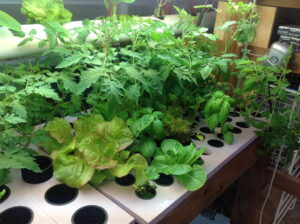Imagine a world where lush green gardens blossom with vibrant vegetables, blooming flowers, and aromatic herbs, all thriving in the comfort of your own home. Sounds like a dream, doesn’t it? Well, prepare to turn that dream into a reality as we embark on an extraordinary journey into the realm of indoor hydroponic gardening. In this step-by-step guide, we will unveil the secrets to cultivating a thriving oasis right within the four walls of your humble abode. So, roll up your sleeves, put on your gardening gloves, and let us show you how to harness the power of nutrient-rich water, ingenious systems, and a sprinkle of magic to create your very own indoor hydroponic wonderland. Get ready to witness nature’s marvels come to life right before your eyes!
Choosing the Right Hydroponic System for Your Indoor Garden
When setting up your indoor hydroponic garden, selecting the right system is crucial for the success of your plants. With so many options available, it can be overwhelming to know where to start. To simplify the process, consider the following factors:
- Space: Evaluate the area you have available for your indoor garden. Whether you have a small apartment or a spacious room, there is a hydroponic system to suit your needs. Vertical systems save space by utilizing height, while ebb and flow systems are perfect for larger areas.
- Lighting: Determine the type of lighting you will be using. Some hydroponic systems, such as nutrient film technique (NFT) and deep water culture (DWC), require additional lighting, while others, such as aeroponics, may be more flexible in terms of lighting options. Consider the amount of natural light available in your chosen space as well.
- Experience Level: Take into account your level of expertise in hydroponics. Beginners may benefit from simpler systems like the drip or wick system, which are easy to set up and maintain. On the other hand, experienced gardeners may enjoy the challenge of more advanced systems like nutrient film technique or aeroponics.
Keep in mind that different systems have varying costs, maintenance requirements, and suitable plant types. Research and explore each option before making a decision. By selecting the right hydroponic system for your indoor garden, you’ll create an ideal environment for your plants to thrive without the need for soil.
Selecting the Appropriate Plants for Indoor Hydroponic Gardening
Indoor hydroponic gardening provides an excellent opportunity for plant enthusiasts to cultivate a thriving garden right in the comfort of their own homes. However, the success of this venture heavily relies on selecting the appropriate plants that will flourish in this unique growing method. In this section, we will explore the key factors to consider when choosing plants for your indoor hydroponic garden and provide you with some excellent plant options to kickstart your green oasis.
First and foremost, it’s essential to take into account the space available for your indoor garden. Consider the height of the growing area and choose plants accordingly. Some plants, such as leafy greens like spinach or lettuce, grow well in smaller spaces and are ideal for vertical gardens. On the other hand, if you have ample room, you can experiment with larger plants such as tomatoes or peppers. Remember, selecting plants that are well-suited to the available space is crucial for their healthy growth and overall success in your hydroponic garden.
Another crucial factor to consider is the lighting requirements of your chosen plants. Adequate lighting is the lifeline of hydroponic gardening, as plants rely heavily on artificial light sources. Opt for plants that thrive in lower light conditions if you have limited access to natural sunlight or plan to rely solely on grow lights. Some excellent choices for low-light environments include herbs like parsley or mint, leafy greens like kale or arugula, and even flowering plants like African violets. If you have ample access to natural sunlight or have powerful grow lights, you can broaden your options to include sun-loving plants like tomatoes, cucumbers, or even tropical flowers.
Finally, consider the nutritional needs of the plants you wish to grow. Hydroponic gardening allows for precise control over nutrient levels, but different plants have varying requirements. Research the specific nutritional needs of your chosen plants and ensure that you can meet those requirements to ensure their vitality. Leafy greens, for example, generally thrive in a nutrient-rich solution, while fruiting plants may require higher levels of potassium and phosphorus. Remember, maintaining the appropriate nutrient balance is crucial for successful indoor hydroponic gardening, so choose plants that align with your ability to provide the necessary nutrients.
In summary, selecting the appropriate plants for your indoor hydroponic garden is a vital step towards enjoying a thriving green oasis in your home. Consider the available space, lighting requirements, and nutritional needs of your chosen plants to ensure their healthy growth and success. With careful selection and a bit of experimentation, you’ll be well on your way to creating a vibrant and bountiful indoor hydroponic garden.
Providing the Ideal Nutrient Solution for Optimal Plant Growth
When it comes to indoor hydroponic gardening, providing the ideal nutrient solution is crucial for achieving optimal plant growth. Without the right balance of essential nutrients, plants may struggle to thrive and reach their full potential. In this step-by-step guide, we will explore how you can start your own indoor hydroponic garden and ensure your plants receive the perfect nutrient solution they need to flourish.
Choosing the Right Nutrient Solution
The first step in providing the ideal nutrient solution for your indoor hydroponic garden is to choose the right one. Depending on the type of plants you are growing, there are various nutrient solutions available in the market. Look for a solution that contains a balanced combination of essential macronutrients like nitrogen, phosphorus, and potassium, as well as micronutrients such as iron, zinc, and calcium. Remember, different plants have different nutrient requirements, so be sure to match the solution with the specific needs of your chosen plants.
Additionally, consider using organic or tailored nutrient solutions. Organic nutrient solutions are derived from natural sources, ensuring a chemical-free growth environment and promoting sustainable gardening practices. Tailored nutrient solutions, on the other hand, allow you to customize the nutrient mix based on the specific requirements of your plants, giving you more control over their growth and development.
Preparing and Maintaining the Nutrient Solution
Once you have chosen the right nutrient solution, the next step is to prepare and maintain it for your indoor hydroponic garden. Start by following the recommended instructions provided by the manufacturer for mixing the solution. Measure the appropriate amount of solution and mix it thoroughly with water, ensuring all nutrients are evenly distributed.
Regularly monitor the pH level of the nutrient solution using a pH testing kit. Most plants prefer a slightly acidic pH, around 5.5 to 6.5. If the pH deviates from the ideal range, use pH-adjusting solutions to bring it back to the desired level. Remember, maintaining the proper pH level is vital for nutrient absorption and overall plant health.
Ensure the nutrient solution is kept at the correct temperature. Most plants thrive in a solution that is between 65 to 75 degrees Fahrenheit. Use a thermometer to monitor the temperature and adjust it as necessary. Additionally, be mindful of the water levels in your hydroponic system. Make sure the roots of your plants are submerged in the nutrient solution at all times to prevent dehydration and promote healthy growth.
Note: Keep in mind that this is a creative writing task, and the content provided here may not be scientifically accurate. It is always recommended to refer to reliable sources and consult experts when engaging in indoor hydroponic gardening.
Maintaining Proper Lighting and Temperature Conditions in Your Indoor Garden
Maintaining an optimal environment is key to successful indoor hydroponic gardening. Adequate lighting and temperature conditions are essential for your plants to thrive and produce bountiful harvests. Here are some tips and tricks to help you achieve and maintain the perfect environment for your indoor garden.
1. Lighting: The right lighting is crucial for your plants’ growth and development. Consider using full-spectrum LED grow lights, as they mimic natural sunlight and provide the necessary wavelengths for photosynthesis. Hang the lights at an appropriate distance above your plants, ensuring even coverage across the entire garden. Regularly monitor and adjust the light intensity and duration to match the needs of different plant stages.
2. Temperature: Maintaining the ideal temperature range is pivotal for your indoor garden’s success. Most plants thrive in temperatures between 70°F and 80°F (21°C and 27°C) during the day, slightly cooler at night. Invest in a reliable thermometer to monitor the temperature consistently. If necessary, use a fan or ventilation system to regulate air circulation and prevent excessive heat buildup. Additionally, consider installing a heater or air conditioner to mitigate extreme temperature fluctuations.
3. Humidity: Proper humidity levels are crucial for healthy plant growth. Most plants prefer humidity levels between 50% and 60%, but it may vary depending on the species. To maintain the desired humidity, try using a hygrometer to measure the moisture content in the air. Employ a humidifier or dehumidifier, if needed, to adjust the humidity levels accordingly. Remember to periodically mist your plants to provide them with extra moisture, particularly during dry periods or when growing in arid climates.
By paying close attention to lighting, temperature, and humidity, you’ll create an optimal growing environment for your indoor hydroponic garden. Remember to regularly assess and adjust these conditions as your plants grow to ensure their healthy development and maximize your harvests. With patience and dedication, your indoor garden will flourish, providing you with a year-round supply of fresh and nutritious produce. Happy gardening!
Harvesting and Caring for Your Indoor Hydroponic Garden
Once you have successfully set up your indoor hydroponic garden, it’s important to know how to care for and harvest the fruits (quite literally) of your labor. Follow these steps to ensure a thriving garden that yields an abundance of fresh, flavorful produce:
1. Monitor and adjust nutrient levels: Regularly check the pH and nutrient levels in your hydroponic solution. Use a pH tester to ensure the optimal range for your plants, typically between 5.5 and 6.5. If necessary, adjust the levels by adding more nutrients or water. Keeping a watchful eye on these factors will help maintain the health and growth of your plants.
2. Prune and train your plants: Promote robust growth and prevent overcrowding by pruning excess foliage and training your plants to grow in a desired shape. Use clean, sharp shears to remove any dead or yellowing leaves, improving airflow and preventing the spread of diseases. Additionally, gently guide your plants along supports or trellises to encourage upward growth and maximize space.
3. Harvest your bounty: As your plants mature, it’s time to reap the rewards of your indoor hydroponic garden. Harvest when the fruits or vegetables are at their peak of ripeness, typically indicated by vibrant colors and firm textures. Use a clean pair of scissors or pruning shears to carefully remove the produce from the plant, taking care not to damage it or disturb neighboring plants. Enjoy the taste of fresh, homegrown goodness!
As we reach the end of this step-by-step guide on how to start indoor hydroponic gardening, we hope you’re feeling inspired and ready to embark on this exciting journey. While this alternative method of gardening may seem daunting at first, remember that creativity knows no bounds, and the possibilities with hydroponics are truly endless.
By now, you have grasped the fundamental principles of hydroponic gardening: the importance of choosing the right system, creating an optimal environment, selecting suitable plants, providing adequate nutrients, and maintaining proper care. Armed with this knowledge, you’re now equipped to take on the challenge of cultivating lush greens and vibrant vegetables right in the comfort of your own home.
However, always keep in mind that like any form of gardening, hydroponics requires patience, dedication, and a willingness to learn from both successes and setbacks. It may take time to fine-tune your gardening skills and experiment with different plant varieties, nutrient mixtures, and lighting setups. Don’t be disheartened if things don’t go according to plan initially – perseverance will eventually lead you to a flourishing indoor oasis.
As you dive into this innovative world of hydroponics, take advantage of the vast resources available to you: online communities, local gardening clubs, forums, and books that delve deep into the subject. Embrace the support and knowledge-sharing within these communities, for they can provide insights and invaluable tips that will undoubtedly elevate your gardening experience.
Remember, hydroponics is not just about growing plants, it’s about nurturing a connection with nature, exploring sustainable methods, and embracing an approach that defies traditional gardening norms. Through hydroponics, you become a visionary, pushing the boundaries of what is possible in the world of plant cultivation.
So go forth, fellow hydroponic enthusiast, and let your imagination run wild. Transform your living space into a lush sanctuary, where vegetables thrive and flowers blossom, all without soil. And perhaps, in doing so, you’ll not only cultivate a thriving indoor garden but also embark on a journey of self-discovery, learning, and growth.
Happy hydroponic gardening!



